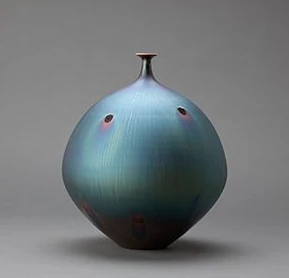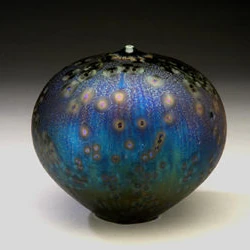Hideaki Miyamura (born in 1955 in Niigata, Niigata, Japan) is a New Hampshire-based Japanese-born American potter. Miyamura is most recognized for his distinctive iridescent glazes, which include a captivating gold glaze, a “starry night” glaze on a black backdrop, and a blue hare’s fur glaze. Miyamura’s glazes are inspired by the tenmoku Chinese glazes used on tea bowls in monasteries in the 12th and 13th centuries.
| Name | Hideaki Miyamura |
| Occupation | Ceramic Artist |
| Born | 1955 Niigata, Japan. Niigata is the capital and the most populous city of Niigata Prefecture located in the Chūbu region of Japan. |
| Nationality | Japanese-born American |
| Known As | Miyamura’s studio pottery |
| Art Style | Ceramics with distinctive iridescent glazes, which include a captivating gold glaze, a “starry night” glaze on a black backdrop, and a blue hare’s fur glaze. |
Hideaki Miyamura Early Life And Career
Japanese-born American potter Hideaki Miyamura (born 1955) lives and works in the state of New Hampshire. In addition to his distinctive iridescent glazes, Miyamura is well known for a captivating gold glaze, the “starry night” glaze on a black backdrop, and a blue hare’s fur glaze, among other things.
He was born in Niigata, Japan, as the son of an architect and a civil engineer, and grew up in the city. Miyamura aspired to be a medical doctor, but he feared the education required would be prohibitively expensive. Instead, he came to the United States and enrolled at Western Michigan University to further his education. Miyamura grew interested in art while studying art history at Western Michigan University. Following college, Miyamura opted to pursue a career in ceramics in Japan.
Miyamura spent more than five years at the studio of master potter Shurei Miura in Yamanashi, Japan, learning his craft. More than ten thousand test pieces were produced during that period, and he used many glaze formulations to create unique glazes that are being used today. Through this procedure, he was able to create glazes that he refers to as “yohen tenmoku,” which are named after a Chinese pottery technique.

During his years as a young potter’s apprentice in Japan, he spent years throwing and polishing forms, eventually reaching the point where my hands and body could create without the need for my conscious mind’s interference. When he first started thinking about working more consciously and creatively, he was motivated by a desire to develop new glazes.
To develop a dark and mysterious glaze evocative of ancient Chinese yohen tenmoku tea bowls in Japan, he conducted hundreds of tests with various materials and firing temperatures. The result was a glaze that reminded me of the boundless night sky on a clear night.
When he first arrived in the United States thirty years ago to pursue his artistic career, he realized that his forms and glazes needed to complement and enhance one another.
He draws inspiration for many of his glazes from the tenmoku style of Chinese glazes from the 12th and 13th centuries that were used on tea bowls in monasteries on Mount Tianmu in Zhejiang province in China during that period. Some have stated that his art is also influenced by Scandinavian ceramics, which they believe is correct.
A total of more than a dozen museums, primarily in the United States, have permanent collections of Miyamura’s studio pottery, including the Art Institute of Chicago, the Arthur M. Sackler Gallery, the Peabody Essex Museum, the Minneapolis Institute of Arts, the Newark Museum of Art, and the Renwick Gallery of the Smithsonian Institution. Miyamura’s studio pottery is represented in the permanent collections of more than a dozen museums, primarily in the United States.
His work has been featured at the Pucker Gallery in Boston on numerous occasions, and his work has also been shown at the Gallery Camino Real in Boca Raton, Florida. He received his education at Western Michigan University, then later in life, he pursued more education under the tutelage of Japanese Master Potter Shurei Miura.
Hideaki Miyamura Style

Miyamura is most known for his remarkable iridescent glazes, which include a mesmerizing gold glaze on a black background, a “starry night” glaze on a black backdrop, and a blue hare’s fur glaze, among others. Japanese potter Miyamura was inspired by the tenmoku Chinese glazes that were used on tea bowls in monasteries in the 12th and 13th centuries, which he recreated in his work.

“The most important formal features are clarity and simplicity of line, which bring his ceramic artwork into harmony with its surroundings and makes for a clean canvas for adding glaze. The unique iridescent glazes Miyamura applies includes a gold glaze, a “starry night” glaze on a black background, and a blue hare’s fur glaze. Miyamura glazes are inspired by the tenmoku glazes used on tea bowls in China in the 12th and 13th centuries.“
Ed Shears

For Miyamura, clarity and simplicity of line are the most significant formal features because they help to bring the work into harmony with its surroundings and provide a clean canvas for the glaze. Every time the shape changes, the glaze appears to be a completely new color.
Recent work includes more architectural shapes, such as squares and hexagons with sharp edges, in which the glaze alters and pools in unexpected ways, as well as more abstract work. These designs are extremely difficult to create since the corners detach and because they are constructed in portions that are then fused after being fused together. In the world of business, the ratio of failure to success is extremely high.
Miyamura has remained inspired by the pursuit of new glazes, and he has relished the years of trial and error that have been required to produce in the form what he believes is conceivable in his imagination. She discovered iridescent glazes in her fifth year of study. Miyamura began experimenting with bronze glazes two years ago, intending to create a remarkable three-dimensional fractal design on the surface.
Even though the glaze appears to be textured and to have optical depth, the surface is extremely smooth. Different chemicals and firing temperatures provide a variety of color variations ranging from rich, calm bronze to inky, soft grey (which is achieved by firing the pieces at the kiln‘s maximum temperature). Other chemical additives to the glaze result in dazzling, diamond-like specks within the fractals as a result of the fractals being fired.
For each piece to seem balanced with the environment (co-exist naturally), Miyamura wants them to appear as if they are coexisting naturally with their (space around) surroundings insuring form interacts naturally. As the form guides both light and the viewer’s sight, it also allows the glaze to alter the perception of form.
YOHEN Crystal glaze
Hideaki Miyamura Artist Vase With Yohen Crystal Glaze
The yohen crystal glaze is not a crystalline glaze. The yohen crystal glaze is a glaze that looks like a crystalline glaze. In reality it has an entirely different formula (and process) than a standard crystalline glaze. The outcome is a delicate starry-night of blacks and blues. This was the most complicated glaze formula Miyamura ever done.
Hideaki Miyamura Collections
- Asian Art Museum of San Francisco, San Francisco, CA
- Art Institute of Chicago, Chicago, IL
- Auckland Institute and Museum, Auckland, New Zealand
- Baltimore Museum of Art, Baltimore, MD
- Carnegie Museum, Pittsburgh, PA
- Crocker Art Museum, Sacramento, CA
- Danforth Museum, Framingham, MA
- Georgetown University, Special Collections, Washington, DC
- Israel Museum, Jerusalem, Israel
- Minneapolis Institute of Art, Minneapolis, MN
- Museum of Arts and Design, New York, NY
- Newark Museum of Art, Newark, NJ
- Nora Eccles Harrison Museum, Utah State University, Logan, UT
- Peabody Essex Museum, Salem, MA
- Renwick Gallery, Smithsonian Institution, Washington, DC
- Sackler Museum, Harvard University, Cambridge, MA
- Springfield Museum of Fine Arts, Springfield, MA
- Tikotin Museum, Haifa, Israel
- USC Pacific Asia Museum, Pasadena, CA
- Victoria and Albert Museum, London, England
- Wheaton College, Norton, MA
Hideaki Miyamura Exhibitions
2021
Memorial Art Gallery Virtual Fine Craft Show, Rochester, NY, November 19-22, 2020
Pucker Gallery, Boston, MA, April 4 to May 31, 2020
2020
League of New Hampshire Craftsmen Virtual Fair
Clarity & Simplicity, Pucker Gallery, Boston, MA
2019
Fine Craft Show, Memorial Art Gallery, Rochester, NY
Gallery Sakuranoki, Karuizawa, Japan
86th Annual League of NH Craftsmen’s Fair
Solo Show Umeda Hankyu, Osaka, Japan
Smithsonian Craft Show, Washington, D.C.
TEFEF, Maastricht, Netherlands
American Craft Council Show, Baltimore, MD
2018
Fine Craft Show, Memorial Art Gallery, Rochester, NY
TEFAF, Park Avenue Armory, New York, NY
“Masterpiece,” London, England
League of New Hampshire Craftsmen Show, Newbury, NH
Smithsonian Craft Show, Washington, DC
Form & Iridescence, Pucker Gallery, Boston, MA
NY Ceramics and Glass Fair, New York, NY
American Craft Council at Baltimore, Baltimore, MD
2017
Fine Craft Show at Memorial Art Gallery of the University of Rochester, NY
Smithsonian Craft Show, National Building Museum, Washington, D.C.
Hankyu Umeda Department Store, Osaka, Japan
American Craft Council show at Baltimore, Baltimore Convention Center
York Ceramics and Glass Fair, Bohemian National Hall
2016
SOFA Chicago, (Contemporary Artifact) Navy Pier, Chicago, IL
Charlotte Contemporary Park Expo. Center, Charlotte, NC.
Resonance & Grace, Pucker Gallery, Boston, MA
2015
Gallery Sakuranoki, Tokyo, Japan
2014
Art Palm Beach, West Palm Beach, FL
SOFA Chicago, Chicago, IL
Lustre, Pucker Gallery, Boston, MA
2013
Gallery Sakura No ki, Tokyo, Japan
Wexler Gallery, Philadelphia, PA
2012
Iridescence, Pucker Gallery, Boston, MA
Galerie Silbereis, Paris, France
2011
Wexler Gallery, Philadelphia, PA
Beauty in All Things: Japanese Art and Design, Museum Arts and Design, New York, NY
2010
Beyond Tenmoku, Pucker Gallery, Boston, MA
2009
Gallery Sakura No Ki, Tokyo, Japan
2008
Resplendent Grace, Pucker Gallery, Boston, MA
2007
SOFA Chicago, Chicago, IL
2006
Pursuing the Eye of Heaven, Pucker Gallery, Boston, MA
2005
Gallery Camino Real, Boca Raton, FL
Katie Gingrass Gallery, Milwaukee, WI
2004
Risk of Discovery, Pucker Gallery, Boston
Fusion of Cultures, Kentucky Museum of Art, Louisville, KY
SOFA New York, New York, NY
2003
SOFA Chicago, Chicago, IL
SOFA New York, New York, NY
2002
SOFA Chicago, Chicago, IL
SOFA New York, New York, NY
Pewabic Pottery, Museum and Education Center, MI
1999
Ayumi Gallery, Tokyo, Japan
1998
Ayumi Gallery, Tokyo, Japan
1993
The Bay State Clay, Fitchburg Museum of Art, Fitchburg, MA
1989
Feats of Clay, Lincoln, CA
Fletcher Challenge Ceramic Award, New Zealand
Supplemental Reading And Sources
- Pucker Gallery, Pursuing the Eye of Heaven: Ceramics by Hideaki Miyamura, Introduction by Andrew L. Maske (Boston: 2005)
- K.T. Anders, “Hideaki Miyamura: A Man of 10,000 Glazes,” 12 Clay Times No. 2 (March/April 2006
Sake Cups
A sake set comprises of the flask and cups used to serve sake. Sake sets are often ceramic, but may be wood, lacquered wood, glass or plastic. The flask and cups may be sold singly or as a set.
References





